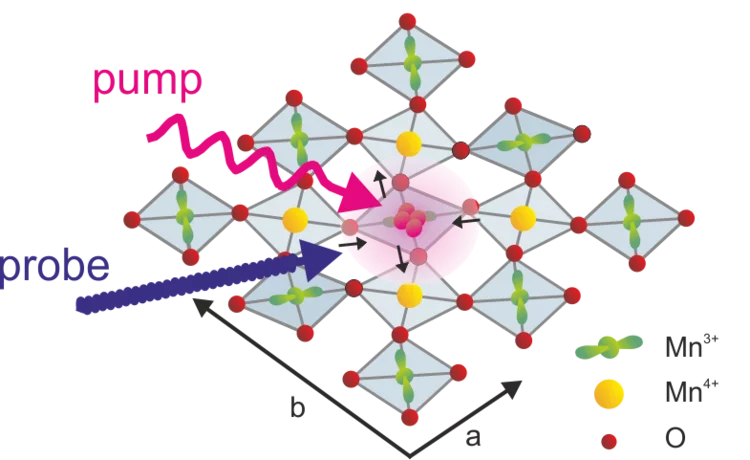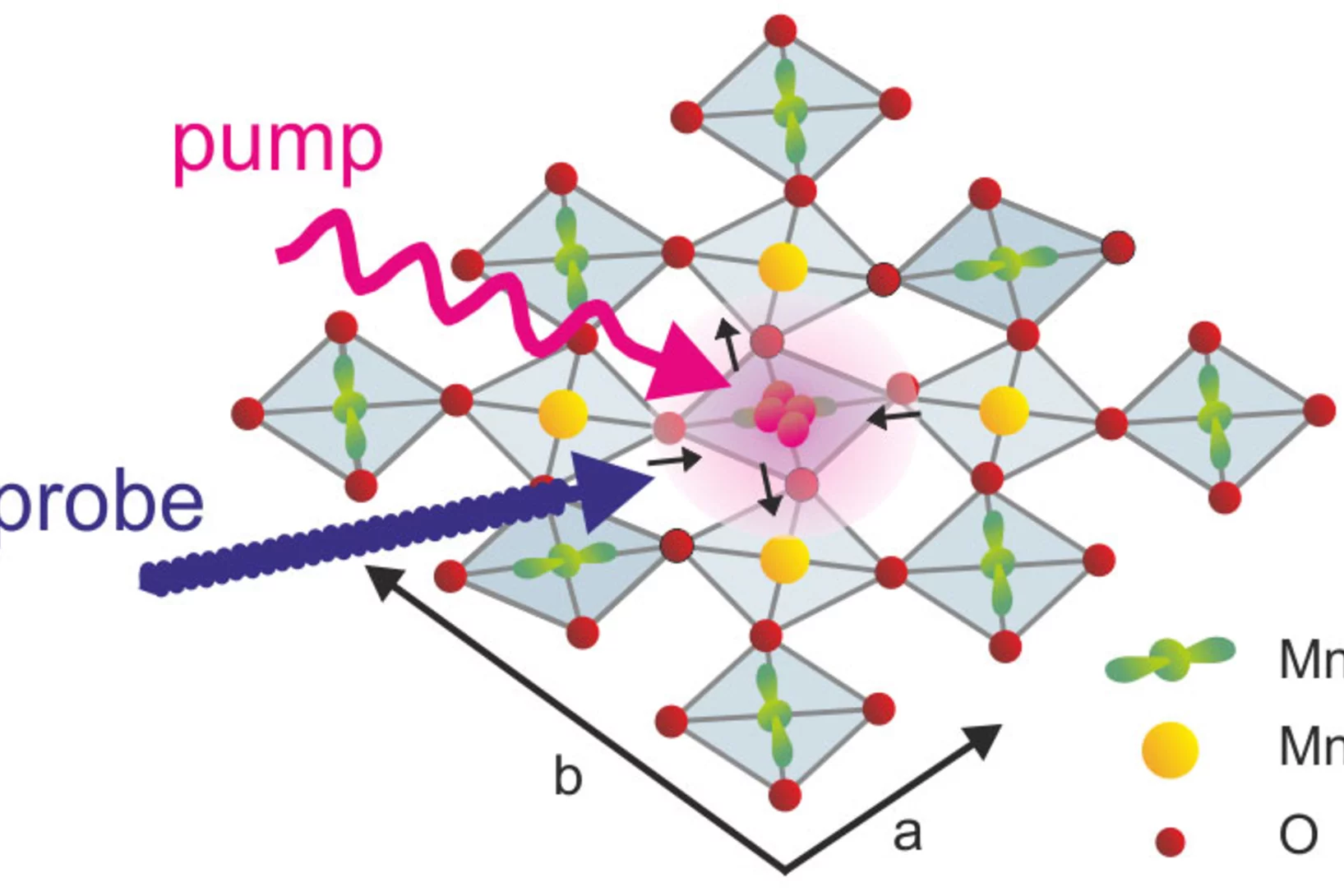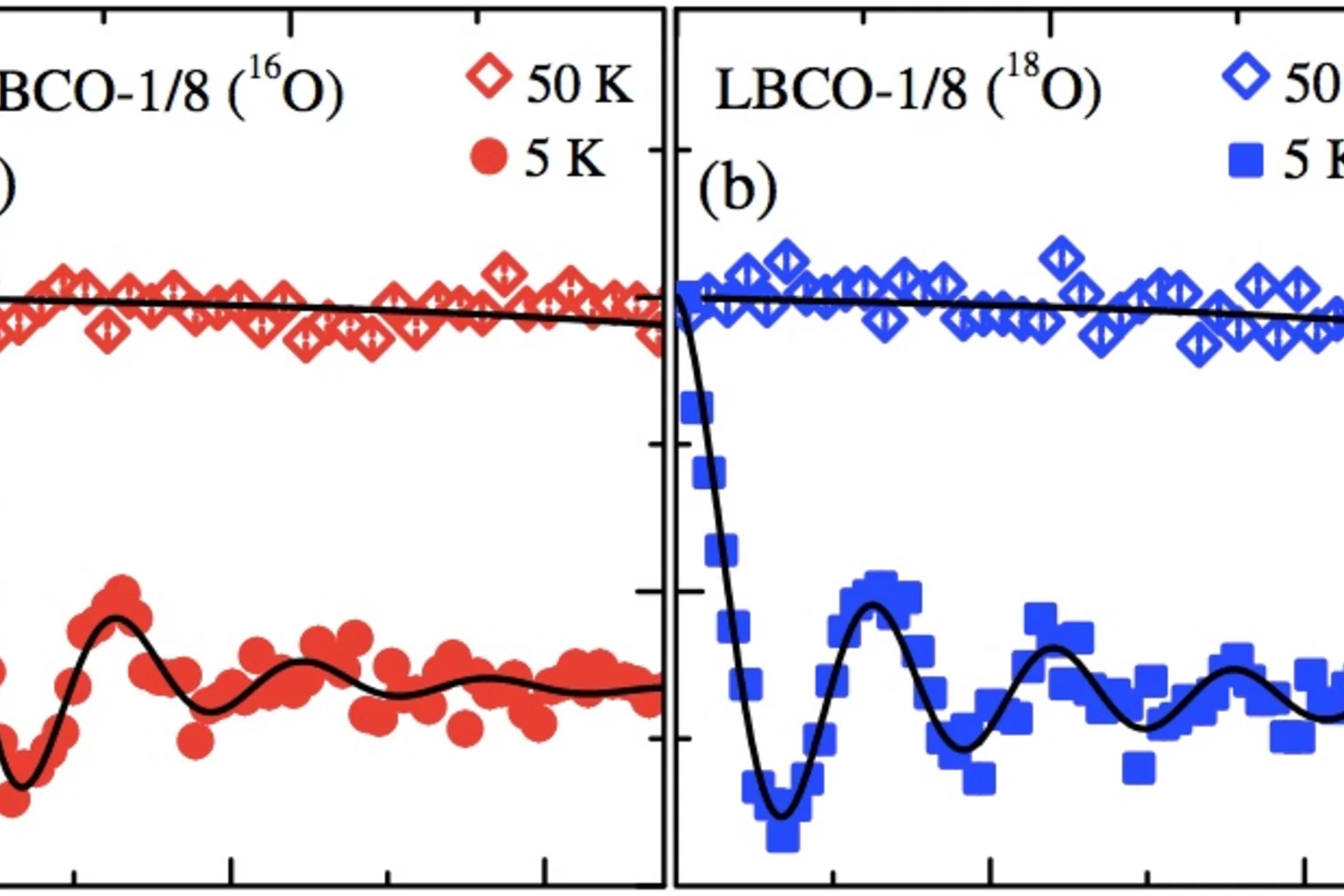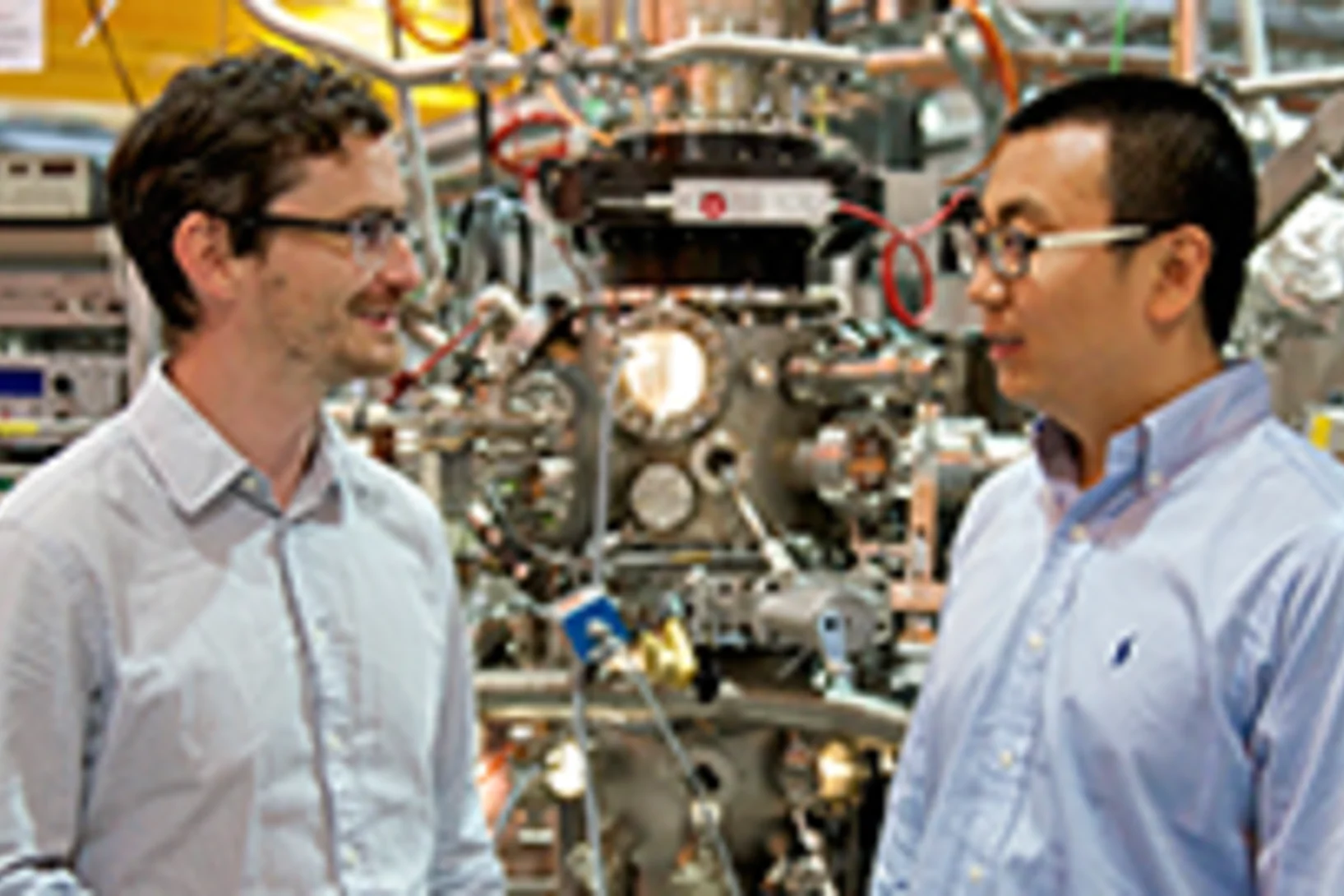Am Paul Scherrer Institut suchen Forschende nach Antworten auf die fundamentale Frage nach den Grundstrukturen der Materie und den fundamentalen Funktionsprinzipien in der Natur. Sie untersuchen Aufbau und Eigenschaften der Elementarteilchen – der kleinsten Bausteine der Materie – oder gehen der Frage nach, wie biologische Moleküle aufgebaut sind und wie sie ihre Funktion erfüllen. Das so gewonnene Wissen öffnet neue Lösungsansätze in Wissenschaft, Medizin oder Technologie.
Mehr dazu unter Überblick Grundlagen der Natur
The μ → eγ decay in a systematic effective field
We implement a systematic effective field theory approach to the benchmark process μ → eγ, performing automated one-loop computations including dimension 6 operators and studying their anomalous dimensions. We obtain limits on Wilson coefficients of a relevant subset of lepton-flavour violating operators that contribute to the branching ratio μ → eγ at one-loop.
Kolosse, die winzige Teilchen steuern
Magnete sind die heimlichen Strippenzieher eines Teilchenbeschleunigers: Sie sorgen dafür, dass Protonen oder Elektronen auf Kurs bleiben. Mit den kleinen Magneten an der heimischen Kühlschranktür haben sie allerdings kaum etwas gemein. Nicht nur sind etliche der Magnete am PSI schwerer als der Kühlschrank selbst à sie sind trotz ihrer Wuchtigkeit Meisterwerke der Präzision.
Ein zuverlässiger Typ aus den 80ern
Ein Linearbeschleuniger im Retro-Look ist der Ursprung des Protonenstrahls am PSI. Benannt nach den Erfindern des Prinzips heisst der charismatische Typ Cockcroft-Walton. Er liefert seit 1984 die erste Beschleunigungsstufe für Protonen, die in der Folge von zwei weiteren Ringbeschleunigern auf schliesslich rund 80 Prozent der Lichtgeschwindigkeit gebracht werden. So entsteht hier seit Jahrzehnten ein beachtenswerter Protonenstrahl, der dank kontinuierlicher Nachrüstungen seit 1994 sogar den Weltrekord als leistungsstärkster Strahl hält.
Airpokalypse erklärt
Wie Chinas rekordhohe Feinstaubbelastung vom Winter 2013 zustande kam.Anfang 2013 deckte eine graubraune Dunstglocke über mehrere Monate weite Teile Chinas zu. Die Feinstaubbelastung übertraf um 1 bis 2 Grössenordnungen die üblicherweise in Westeuropa oder USA gemessenen Werte. Nun deckt ein international zusammengesetztes Forscherteam unter der Leitung des Paul Scherrer Instituts PSI und der chinesischen Akademie für Wissenschaften CAS in Xi’an die Quellen hinter der Airpokalypse auf. Die in der Zeitschrift Nature veröffentlichte Studie zeigt auch, mit welchen Massnahmen einer solchen Umweltkrise in Zukunft vorgebeugt werden kann.
Energiewende in Reinkultur – in Wädenswil zu bestaunen
Der am Paul Scherrer Institut PSI entwickelte Prozess der hydrothermalen Methanierung von wässriger Biomasse erreicht einen wichtigen Meilenstein: Dank der Zusammenarbeit im neuen Kompetenzzentrum des Bundes für Bioenergie BIOSWEET konnten Forschende des PSI, der ZHAW, der ETH Lausanne, der Empa und der Hochschule für Technik Rapperswil die technische Machbarkeit der Methanherstellung aus Mikroalgen demonstrieren. Der dazu verwendete Algenbioreaktor sowie die Anlage zur Methanierung der Algen können am 24. September auf dem Campus Grüental der ZHAW in Wädenswil besichtigt werden. Für Medienschaffende gibt es von 14:00 bis 14:30 eine spezielle Führung.
Electric-Field-Induced Skyrmion Distortion and Giant Lattice Rotation in the Magnetoelectric Insulator Cu2OSeO3
Discovering fundamentally new ways to manipulate magnetic spins is crucial for research into advanced technologies. Magnetic Skyrmions, which are topologically stable whirls of magnetic spins, are promising candidates for new device components since those found in metallic host materials can be manipulated using electric currents.
Mit Licht neues Material erzeugt
Forschende des Paul Scherrer Instituts haben mithilfe kurzer Lichtblitze aus einem Laser die Eigenschaften eines Materials kurzzeitig so deutlich verändert, dass gewissermassen ein neues Material entstanden ist und die Veränderungen am Röntgenlaser LCLS in Kalifornien untersucht. Nach der Inbetriebnahme des PSI-Röntgenlasers SwissFEL werden solche Experimente auch am PSI möglich sein.
Controlling the near-surface superfluid density in under doped YBa2Cu3O6+x by photo-illumination
The interaction with light weakens the superconducting ground state in classical superconductors. The situation in cuprate superconductors is more complicated: illumination increases the charge carrier density, a photo-induced effect that persists below room temperature. Furthermore, systematic investigations in underdoped YBa2Cu3O6+x (YBCO) have shown an enhanced critical temperature Tc. Until now, studies of photo-persistent conductivity (PPC) have been limited to investigations of structural and transport properties, as well as the onset of superconductivity.
Low-temperature solid-oxide fuel cells based on proton-conducting electrolytes
The need for reducing the operating temperature of solid-oxide fuel cells (SOFCs) imposed by cost reduction has pushed significant progress in fundamental understanding of the individual components, as well as materials innovation and device engineering. Proton-conducting oxides have emerged as potential alternative electrolyte materials to oxygen-ion conducting oxides for operation at low and intermediate temperatures.
Plasma interactions determine the composition in pulsed laser deposited thin films
Plasma chemistry and scattering strongly affect the congruent, elemental transfer during pulsed laser deposition of target metal species in an oxygen atmosphere. Studying the plasma properties of La0.6Sr0.4MnO3, we demonstrate for as grown La0.6Sr0.4MnO3-δ films that a congruent transfer of metallic species is achieved in two pressure windows: ∼10−3 mbar and ∼2 × 10−1 mbar.
Mixed Dimensionality of Confined Conducting Electrons in the Surface Region of SrTiO3
Using angle-resolved photoemission spectroscopy, we show that the recently discovered surface state on SrTiO3 consists of nondegenerate t2g states with different dimensional characters.
Schon frühe Säugetiere waren beim Essen wählerisch
Aktuellste Untersuchungen an Fossilien winziger Säugetiere aus dem südlichen Wales liefern neue Erkenntnisse über den Speisezettel unserer frühesten Vorfahren. Dabei stellte sich heraus, dass à anders als bislang vermutet - schon bei den frühesten Säugetieren verschiedene Arten auf verschiedene Nahrung spezialisiert waren. Darüber berichten Forschende Forscher der Universitäten Bristol und Leicester in der neuesten Ausgabe des Fachjournals Nature. Ihre Erkenntnisse beruhen auf Untersuchungen, die mithilfe von Röntgentomografie an der Synchrotron Lichtquelle Schweiz SLS des Paul Scherrer Instituts durchgeführt wurden. Die Ergebnisse helfen zu verstehen, wie Eigenschaften entstanden sind, die heutige Säugetiere auszeichnen.
A revealing mixture: The surface of an oxide insulator can host two distinct types of conducting electrons
Strontium titanate, SrTiO3, is an important material for the realization of next-generation electronic devices. A famous example is the interface of LaAlO3 grown on SrTiO3, which is metallic and magnetic at its interface, even though the individual compounds are insulating and nonmagnetic in bulk form. The physics behind how novel interface states form on SrTiO3 - and how they become endowed with such surprising properties - is not well understood.
Spin-lattice coupling induced weak dynamical magnetism in EuTiO3 at high temperatures
EuTiO3, which is a G-type antiferromagnet below TN = 5.5 K, has some fascinating properties at high temperatures, suggesting that macroscopically hidden dynamically fluctuating weak magnetism exists at high temperatures. This conjecture is substantiated by magnetic field dependent magnetization measurements, which exhibit pronounced anomalies below 200 K becoming more distinctive with increasing magnetic field strength. Additional results from muon spin rotation experiments provide evidence for weak fluctuating bulk magnetism induced by spin-lattice coupling which is strongly supported in increasing magnetic field.
Low-Temperature Micro-Solid Oxide Fuel Cells with Partially Amorphous La0.6Sr0.4CoO3-δ Cathodes
Partially amorphous La0.6Sr0.4CoO3-δ (LSC) thin-film cathodes are fabricated using pulsed laser deposition and are integrated in free-standing micro-solid oxide fuel cells (micro-SOFC) with a 3YSZ electrolyte and a Pt anode. A low degree of crystallinity of the LSC layers is achieved by taking advantage of the miniaturization of the cells, which permits low-temperature operation (300–450 °C).
Was Angriffe auf Ölpipelines mit Seuchen gemein haben
Wie anfällig ist die globale Energieinfrastruktur für Angriffe durch nichtstaatliche Akteure? Hat die Anzahl der Anschläge auf diese Infrastruktur in letzter Zeit tatsächlich zugenommen? Welche Weltregionen sind besonders verwundbar? Und welche Taktiken wenden die Angreifer an? Antworten auf diese und weitere verwandte Fragen wollen Wissenschaftler mit Hilfe einer Datenbank finden, die Forschende des Center of Security Studies der ETH Zürich in Zusammenarbeit mit Kollegen des Paul Scherrer Instituts PSI entwickelt haben.
Correlated Decay of Triplet Excitations in the Shastry-Sutherland Compound SrCu2(BO3)2
The temperature dependence of the gapped triplet excitations (triplons) in the 2D Shastry-Sutherland quantum magnet SrCu2(BO3)2 is studied by means of inelastic neutron scattering. The excitation amplitude rapidly decreases as a function of temperature, while the integrated spectral weight can be explained by an isolated dimer model up to 10 K.
Fast scanning coherent X-ray imaging using Eiger
The smaller pixel size, high frame rate, and high dynamic range of next-generation photon counting pixel detectors expedites measurements based on coherent diffractive imaging (CDI). The latter comprises methods that exploit the coherence of X-ray synchrotron sources to replace imaging optics by reconstruction algorithms. Researchers from the Paul Scherrer Institut have recently demonstrated fast CDI image acquisition above 25,000 resolution elements per second using an in-house developed Eiger detector. This rate is state of the art for diffractive imaging and even on a par with the fastest scanning X-ray transmission instruments. High image throughput is of crucial importance for both materials and biological sciences for studies with representative population sampling.
Square dance of the atoms: Shedding light on ultrafast phase transitions
The exploration of the interaction of structural and electronic degrees of freedom in strongly correlated electron systems on the femtosecond time scale is an emerging area of research. One goal of these studies is to advance our understanding of the underlying correlations, another to find ways to control the exciting properties of these materials on an ultrafast time scale.
Square dance of the atoms: Shedding light on ultrafast phase transitions
The exploration of the interaction of structural and electronic degrees of freedom in strongly correlated electron systems on the femtosecond time scale is an emerging area of research. One goal of these studies is to advance our understanding of the underlying correlations, another to find ways to control the exciting properties of these materials on an ultrafast time scale. So far a general model is lacking that provides a quantitiative description of the correlations between the structural and electronic degrees of freedom.
Negative Oxygen Isotope Effect on the Static Spin Stripe Order in Superconducting La2−xBaxCuO4(x=1/8) Observed by Muon-Spin Rot
Large negative oxygen-isotope (16O and 18O) effects (OIEs) on the static spin-stripe-ordering temperature Tso and the magnetic volume fraction Vm were observed in La2−xBaxCuO4(x=1/8) by means of muon-spin-rotation experiments. The corresponding OIE exponents were found to be αTso=-0.57(6) and αVm=-0.71(9), which are sign reversed to αTC=0.46(6) measured for the superconducting transition temperature Tc. This indicates that the electron-lattice interaction is involved in the stripe formation and plays an important role in the competition between bulk superconductivity and static stripe order in the cuprates.
Direct observation of the spin texture in SmB6 as evidence of the topological Kondo insulator
Topological Kondo insulators have been proposed as a new class of topological insulators in which non-trivial surface states reside in the bulk Kondo band gap at low temperature due to strong spin–orbit coupling. In contrast to other three-dimensional topological insulators, a topological Kondo insulator is truly bulk insulating. Furthermore, strong electron correlations are present in the system, which may interact with the novel topological phase. By applying spin- and angle-resolved photoemission spectroscopy, here we show that the surface states of SmB6 are spin polarized. The spin is locked to the crystal momentum, fulfilling time reversal and crystal symmetries.
Geordneter Elektronenfluss im Isolator
Forschende des PSI, der EPFL und der Chinesischen Akademie der Wissenschaften haben gezeigt, dass das Material SmB6 alle Eigenschaften eines topologischen Isolators zeigt, also eines Materials, an dessen Oberfläche polarisierte Ströme fliessen können. Das Besondere an diesem Material ist, dass die Eigenschaft sehr robust ist à an der Materialoberfläche fliessen nur polarisierte Ströme und die Eigenschaft bleibt auch bei kleinen Unregelmässigkeiten in der Struktur oder Zusammensetzung des Materials erhalten. Polarisierte Ströme sind für die Spintronik à Elektronik, die den Elektronenspin nutzt à wichtig.
Small-angle neutron scattering study of the mixed state of Yb3Rh4Sn13
Using the small angle neutron scattering (SANS) technique we investigated the vortex lattice (VL) in the mixed state of the stannide superconductor Yb3Rh4Sn13. We find a single domain VL of slightly distorted hexagonal geometry for field strengths between 350 and 18 500 G and temperatures between T=0.05 and 6.5 K. We observe a clear in-plane rotation of the VL for different magnetic field directions relative to the crystallographic axes.
Spin-Wave Spectrum of the Quantum Ferromagnet on the Pyrochlore Lattice Lu2V2O7
Neutron inelastic scattering has been used to probe the spin dynamics of the quantum (S=1/2) ferromagnet on the pyrochlore lattice Lu2V2O7. Well-defined spin waves are observed at all energies and wave vectors, allowing us to determine the parameters of the Hamiltonian of the system.
Wasserstoff: ein trojanisches Pferd im Brennstab-Hüllrohr
In Kernreaktoren wird an den heissen Brennelementen Wasser aufgespalten, wobei Wasserstoff entsteht. Der Wasserstoff kann in das Hüllrohr, das den eigentlichen Brennstoff umgibt, eindringen und dieses mechanisch schwächen. Forschende des Paul Scherrer Instituts PSI untersuchen mit Hilfe von Neutronen und Synchrotronstrahlung, wie der Wasserstoff ins Hüllrohr kommt, und welche Wirkung er darin entfalten kann.
Polychlorinated biphenyls in glaciers
We present a highly time-resolved historical record of polychlorinated biphenyls (PCBs) from an Alpine ice core (Fiescherhorn glacier, Switzerland). Introduced in the 1940s, PCBs were widely used industrial chemicals. Because of their persistence they are still found in the environment, long after their production phase-out. The Fiescherhorn ice core record covers the entire time period of industrial use of PCBs, that is, 1940?2002. The total concentration of six PCBs varies from 0.5 to 5 ng/L and reveals a temporal trend, with an 8-fold increase from the early 1940s to the peak value in the 1970s.
Coherent structural dynamics of a prototypical Charge-Density-Wave-to-Metal transition
In so called charge-density-wave compounds, the peculiar shape of the Fermi surface as well as electron-phonon coupling lead to a low-temperature broken symmetry ground state. This state is characterized by a modulation of the charge density (hence the name) and, via electron-phonon coupling, a distortion of the equilibrium lattice positions.
Origin of Anomalous Slip in Tungsten
Low-temperature deformation of body-centered cubic metals shows a significant amount of plastic slip on planes with low shear stresses, a phenomenon called anomalous slip. Despite progress in atomistic modeling of the consequences of complex stress states on dislocation mobility, the phenomenon of anomalous slip remained elusive. Using in situ Laue microdiffraction and discrete dislocation dynamics in micrometer sized tungsten single crystals, we demonstrate the occurrence of significant anomalous slip. It occurs as a consequence of cross kinks, topological configurations generated by prior dislocation interactions.
Identification of transitions between liquid water and ice with dual spectrum neutron imaging
The ability to start up at sub-zero Celsius temperatures is a prerequisite for the use of fuel cells in automotive applications, but specific measures need to be taken to prevent the product water to freeze and block the gas supply pathways. In this context, a method for imaging the distribution of liquid water and ice from neutron imaging experiments was developed.






























